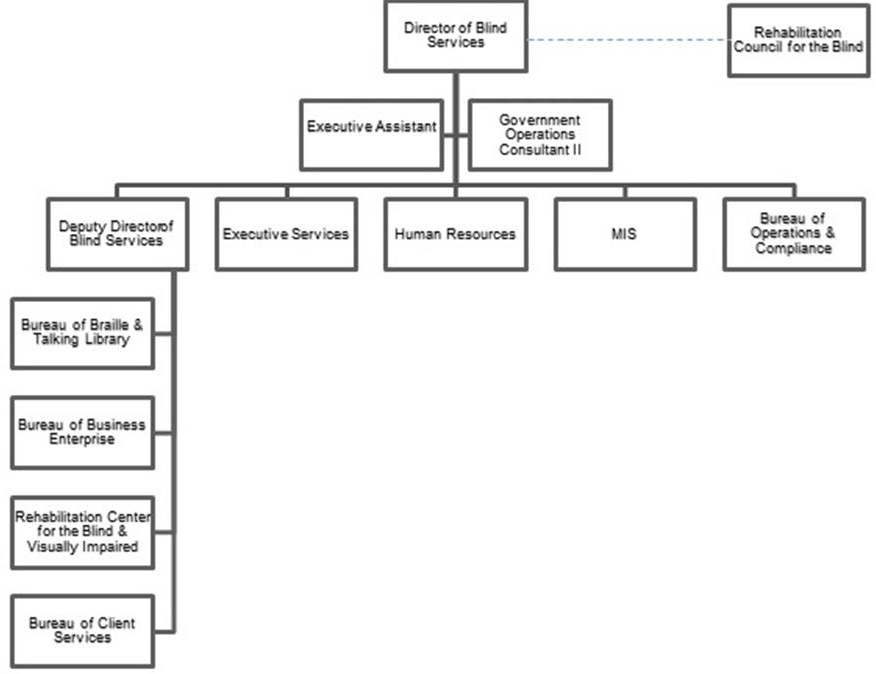Located in:
- III. Operational Planning ElementsThe Unified or Combined State Plan must include an Operational Planning Elements section that support the State’s strategy and the system-wide vision described in Section II.(c) above. Unless otherwise noted, all Operational Planning Elements apply to Combined State Plan partner programs included in the plan as well as to core programs. This section must include—
- b. State Operating Systems and PoliciesThe Unified or Combined State Plan must include a description of the State operating systems and policies that will support the implementation of the State strategy described in Section II Strategic Elements . This includes—
- b. State Operating Systems and Policies
III. b. 3. A. State Agency Organization
Current Narrative:
Deparmtent of Economic Opportunity
Florida’s workforce system was recently rebranded and is now known as the CareerSource Florida network. The network consists of CareerSource Florida, the statewide workforce policy and investment board, 24 local workforce development boards, and the nearly 100 one-stop career centers they direct to provide local services to job seekers, workers, and businesses. The network also includes the Florida Department of Economic Opportunity (DEO), the state’s administrative and fiscal entity for workforce programs. The CareerSource Florida network is a key component of Florida’s Talent Supply System, which encompasses public and private education and training through a continuum from pre-kindergarten, primary/secondary and post-secondary to workforce development/lifelong learning.
The Department of Economic Opportunity (DEO) is the governor’s agency for workforce support and training, economic development, and community development. DEO partners with CareerSource Florida and the state’s 24 Local Workforce Development boards (LWDBs) to strengthen Florida’s business climate by supporting employers and helping Floridians gain employment, remain employed, and advance in their careers. DEO oversees the administration of the state’s workforce system and receives and accounts for federal funds on behalf of the system. DEO is responsible for financial and performance reporting to USDOL and other federal organizations, distributing workforce guidance and policy initiatives, providing training and technical assistance to LWDBs, and providing other administrative functions. DEO also operates Florida’s Reemployment Assistance program, Labor Market Statistics program, and a number of other programs and initiatives.
Local career centers established by the state’s local workforce development boards are truly one-stop centers that offer a variety of business and job applicant services at one physical location. The local career centers use Wagner-Peyser and WIOA funding as the foundational grants that support the infrastructure costs of the centers. Shared costs paid by other workforce programs such as TANF and SNAP reduce the overall costs of the system to those two foundational grants. Programs and services are carried out by DEO and the business-led LWDBs, with an array of services delivered through the career centers throughout Florida and through the state’s online job matching system, Employ Florida Marketplace (EFM), at www. employflorida.com. Programmatic and administrative requirements are set forth in a Grantee-Sub-grantee Agreement executed by DEO and each LWDB requiring their compliance with all federal and state laws, regulations and any special state requirements.
Customers have access to labor market information; have access to the state’s labor exchange job matching system (Employ Florida Marketplace); have access to resource rooms that have computers that are internet enabled; have access to training services; and, have access to assistance in meeting work requirements in the TANF and SNAP programs. Businesses have access to job applicants and assistance in upgrade training for existing employees who need training to either retain their jobs or move up a career ladder. Local Boards also work with their local educational partners and community organizations to offer services under the WIOA Youth Program.
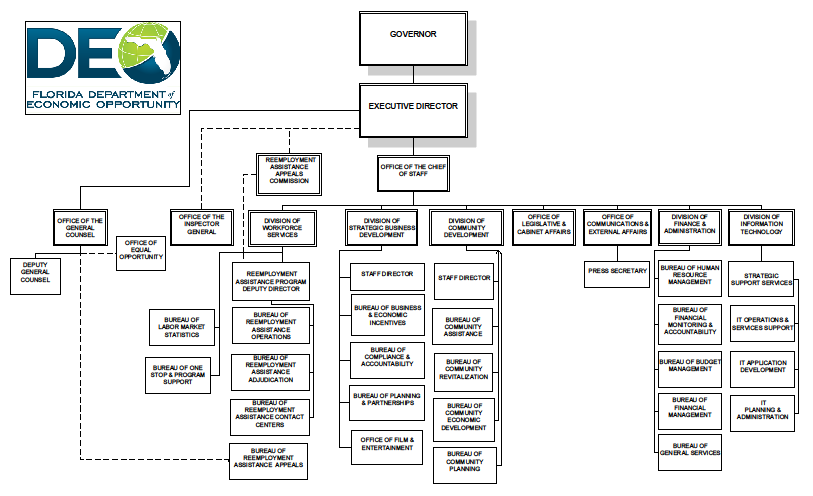
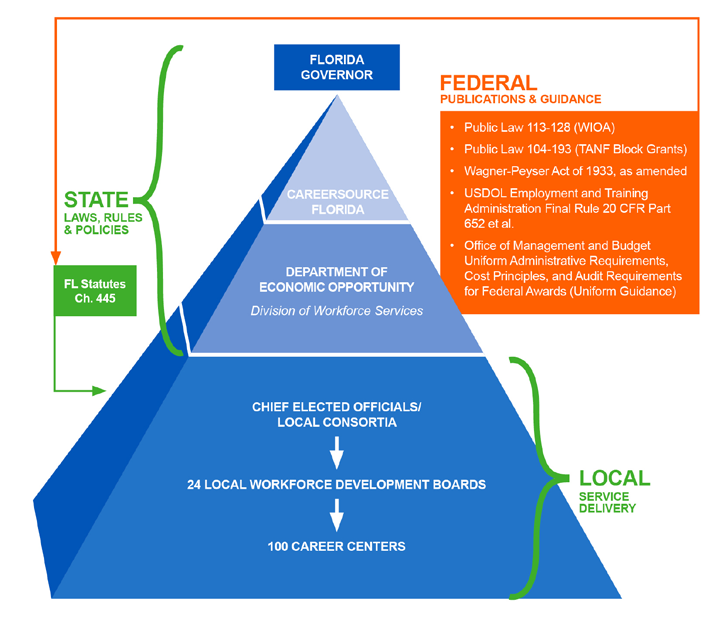
Florida Department of Education
The mission of the Florida Department of Education (FDOE) is “to increase the proficiency of all students within one seamless, efficient system, by providing them with the opportunity to expand their knowledge and skills through learning opportunities and research valued by students, parents, and communities, and to maintain an accountability system that measures student progress.”
FDOE serves nearly 2.7 million students, 4,200 public schools, 28 colleges, 192,000 teachers, 47,000 college professors and administrators, and 321,000 full-time staff throughout the state; the department enhances the economic self-sufficiency of Floridians through programs and services geared toward college, workforce education, apprenticeships, job-specific skills, and career development. The department manages programs that assist individuals who are blind, visually-impaired, or disabled succeed either in school settings or careers - encouraging independence and self-sufficiency. FDOE provides oversight to 28 locally-governed public state colleges and 47 school district technical centers.
FDOE includes more than 2,400 total full-time positions, including 930 positions in the Division of Vocational Rehabilitation, 300 positions in the Division of Blind Services and 84 positions in the Division of Career and Adult Education. The department’s annual operating budget for all entities in state fiscal year 2015-16 is approximately $22.9 billion.
The FDOE organizational and governance structure includes the State Board of Education. The State Board of Education consists of seven members appointed by the Governor to staggered four-year terms, subject to confirmation by the Senate. The State Board of Education is the chief implementing and coordinating body of public education in Florida, except for the State University System. The state board focuses on high-level policy decisions and has the authority to adopt rules to implement the provisions of law. General duties include, but are not limited to, adopting education objectives and long-range plans for public education in Florida, exercising general supervision over the Department, submitting an annual coordinated PreK-20 education budget, and adopting uniform standards of student performance.
FDOE policies and operations are led by the department’s senior leadership team, consisting of the commissioner of education, chief of staff, division leaders and directors of support divisions (see organizational chart below). FDOE manages the core WIOA programs for adult and career education, vocational rehabilitation, and blind services. The senior leader team develops strategies, designs operational policies, and manages the department’s business processes. Senior leader meetings are held on a weekly basis, and strategy development meetings are conducted quarterly. Strategies are tracked and adjusted as needed. Overall FDOE financial and operational performance is reported on a regularly scheduled basis to the federal Department of Education, Florida Legislature, and the office of the Governor.
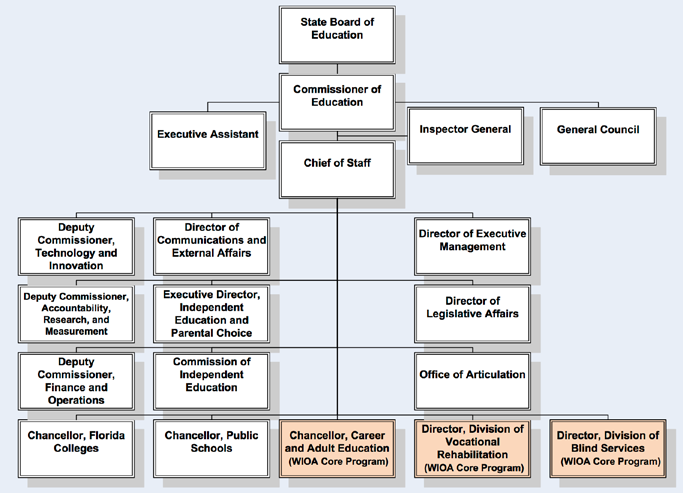
Adult Education
The Division of Career and Adult Education (DCAE) has oversight over the adult education system implemented in districts, colleges and community-based organizations and coordinates the distribution of federal adult education grants. DCAE works closely with the local programs and provides guidance on state and federal guidelines, professional development, support in reporting data, and technical assistance on program improvement plans.
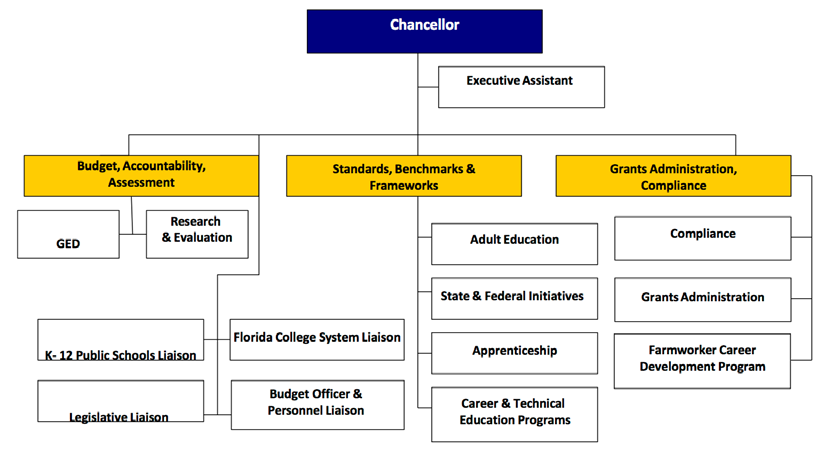
Division of Vocational Rehabilitation
The Florida Division of Vocational Rehabilitation (VR) is a federally established program under the Rehabilitation Act, as Amended (1998), and reauthorized as a core program of WIOA (2014). The VR program is funded as a federal-state partnership, in which 21.3% of state general revenue matches 78.7% federal grant. Most programmatic oversight and governance is established in the federal laws and code of federal regulations. New federal regulations under WIOA are still in draft. Florida state laws for vocational rehabilitation are located in Chapter 413, Florida Statutes. VR is responsible for providing annual planning updates and annual / quarterly performance and financial reports to the federal Rehabilitation Services Administration (RSA). RSA conducts regulatory and programmatic monitoring and oversight activities in all VR agencies in the country approximately once every four years.
WIOA also retains the presence of a state rehabilitation council, known as the Florida Rehabilitation Council (FRC). Council members are volunteers and represent a variety of perspectives from the disability community. They are appointed by the governor. Although the council is not a governance board, the council is required by federal law to review, analyze, and advise VR. VR management takes council recommendations under advisement. Key collaborative activities with the council include input and recommendations for the VR services portion of the state plan, key programmatic policies, assessing VR customer satisfaction, and the progress and outcomes of administrative hearings for VR customers.
Within Florida, VR is a division of the Department of Education. Technically, VR policies and operations organizationally reside under the authority of the state board of education. However, VR historically designs operational policies, develops strategies, and operates business processes with a minimum of functional oversight of the board. The VR Director does participate in regular meetings with FDOE senior leadership, including high-level agency-wide strategic planning activities. The Director is supervised by the FDOE chief of staff, and has ready access to discuss operational activities that affect VR.
VR maintains a consistent approach for divisional governance and decision-making. The division conducts monthly senior leadership meetings to share information and determine policy direction. Division leadership also conducts monthly financial management meetings and quarterly strategic planning and information technology meetings. VR also has similar governance structures in each of its six geographic areas across the state. VR is comprised of a headquarters office, 6 area offices, and 93 offices strategically located throughout Florida where customers receive direct VR services.
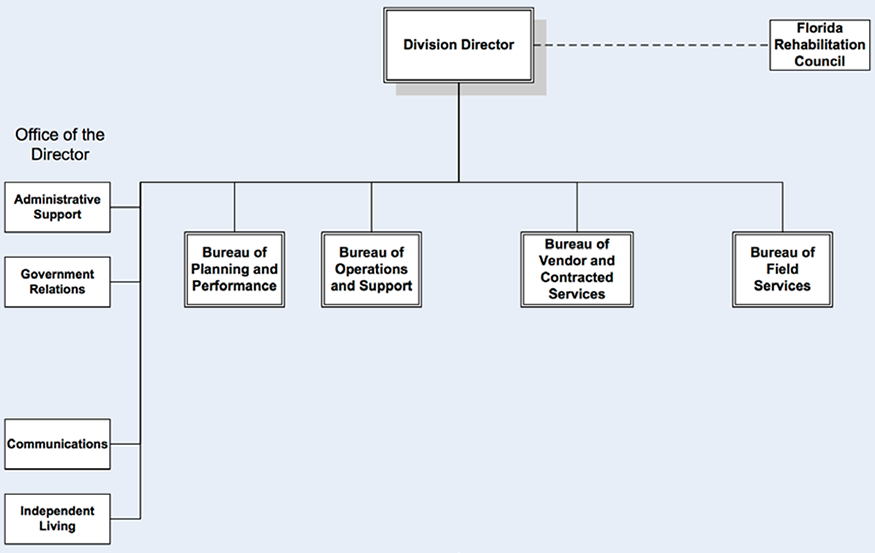
Division of Blind Services
The Florida Division of Blind Services (FDBS) is a federally established program under the Rehabilitation Act, as Amended (1998), and reauthorized as a core program of WIOA (2014). The FDBS vocational rehabilitation program is funded as a federal-state partnership. FDBS is part of the Florida Department of Education and serves blind and visually impaired Floridians. Coordination of Services is administered through 15 FDBS office locations across the state utilizing a combination of state, federal and community funding. In partnership with community rehabilitation providers and other local partners, the division provides services for individuals based on their individual needs.
